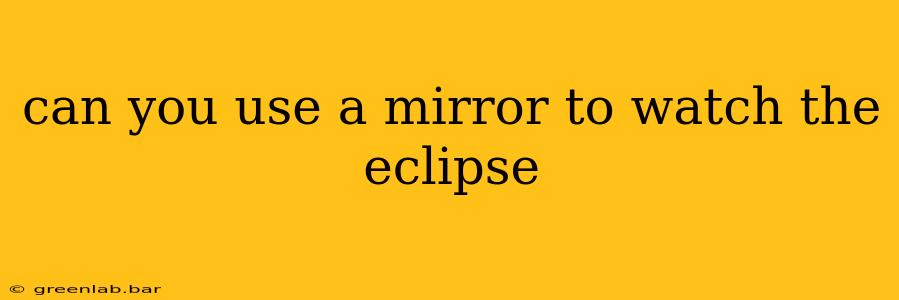Can You Use a Mirror to Watch the Eclipse? A Definitive Guide to Safe Solar Viewing
Watching a solar eclipse is a breathtaking experience, but looking directly at the sun, even during an eclipse, can cause serious and permanent eye damage. So, can you use a mirror to watch the eclipse? The short answer is: no, not safely. While a mirror might seem like a clever workaround, it's actually incredibly dangerous.
Here's why you shouldn't use a mirror to view a solar eclipse, and what safe alternatives you should consider:
The Dangers of Using a Mirror to View a Solar Eclipse
A mirror reflects sunlight, concentrating its intense rays. Looking at the reflected sunlight, even indirectly, can lead to:
- Solar Retinopathy: This is damage to the retina, the light-sensitive tissue at the back of your eye. It can cause blurry vision, blind spots, and even complete vision loss. The damage is often irreversible.
- Photokeratitis: This is a sunburn of the cornea, the outer layer of your eye. Symptoms include pain, redness, and blurred vision. While usually temporary, it can be incredibly uncomfortable.
Even a small amount of time looking at the sun's reflection in a mirror can cause significant damage. The intensity of the sunlight is amplified by the mirror's reflective surface, making it far more dangerous than looking directly at the sun without any protection.
Safe Ways to View a Solar Eclipse
There are many safe and effective ways to witness this spectacular celestial event without risking your eyesight:
- ISO 12312-2 Certified Solar Glasses: These are specially designed glasses with filters that block out almost all of the sun's harmful rays. Crucially, ensure they meet the ISO 12312-2 standard. Do not use regular sunglasses, smoked glass, or homemade filters – these offer inadequate protection.
- Solar Viewers: These handheld devices project an image of the sun onto a screen, allowing you to safely observe the eclipse.
- Indirect Projection: This involves projecting the sun's image onto a surface using a pinhole projector or a telescope (with the proper solar filter attached). There are many DIY tutorials available online explaining how to build a pinhole projector safely.
Why Other Methods Don't Work (And Are Dangerous)
Many methods people might consider are simply not safe, including:
- Sunglasses: Regular sunglasses, no matter how dark, do not provide sufficient protection.
- Camera Viewfinders: Looking through a camera's viewfinder is dangerous, as the concentrated sunlight can damage your eyes.
- CDs or DVDs: These offer minimal protection and are not recommended for solar viewing.
- Polarized filters: Whilst frequently suggested for photography purposes, polarized filters do not provide adequate protection against solar radiation, presenting a serious health risk.
Conclusion:
Viewing a solar eclipse is a rewarding experience, but protecting your eyesight is paramount. Never use a mirror to view the sun, and always prioritize certified solar viewing glasses or an indirect projection method. Prioritize your eye health and enjoy the eclipse safely!
Disclaimer: This information is for educational purposes only. Always consult with a qualified ophthalmologist or astronomy expert for any questions regarding safe solar viewing practices.

